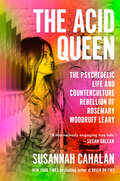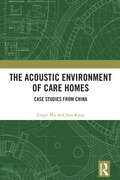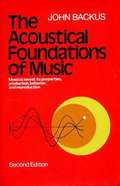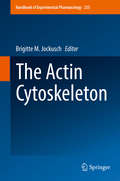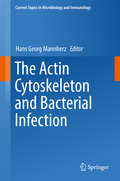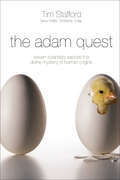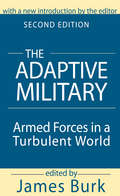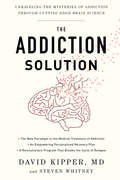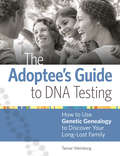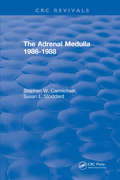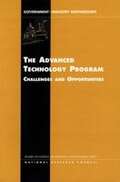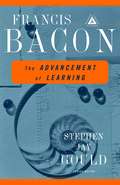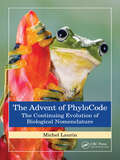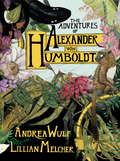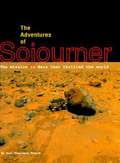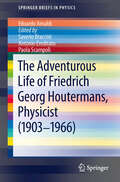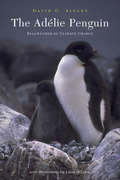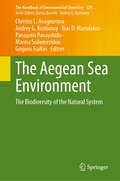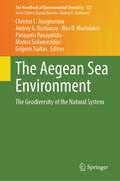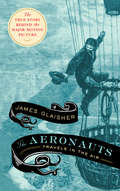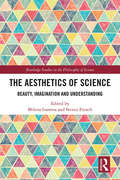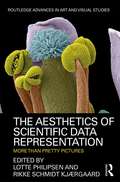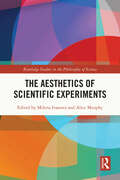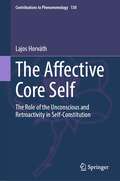- Table View
- List View
The Acid Queen: The Psychedelic Life and Counterculture Rebellion of Rosemary Woodruff Leary
by Susannah Cahalan&“Shines a light on one of the twentieth century&’s most amazing untold life stories. ... An essential read—and an unforgettable trip.&” —Robert Kolker, author of Hidden Valley Road &“Cahalan details a piece of lost but fascinating history, the story of a woman who embodied an era of freedom, experimentation, and psychedelic adventure. Meticulously reported and beautifully crafted.&” —Susan OrleanThe untold story of the woman who played a critical role in bringing psychedelics into the mainstream—until her audacious exploits forced her into the shadows—from the #1 New York Times bestselling author of Brain on FireRosemary Woodruff Leary has been known only as the wife of Timothy Leary, the Harvard professor-turned-psychedelic high priest, whose jailbreak captivated the counterculture and whose life on the run with Rosemary inflamed the government. But Rosemary was more than a mere accessory. She was a beatnik, a psychonaut, and a true believer who tested the limits of her mind and the expectations for women of her time.Long overlooked by those who have venerated her husband, Rosemary spent her life on the forefront of the counterculture, working with Leary on his books and speeches, sewing his clothing, and shaping—for better and for worse—the media&’s narrative about LSD. Ultimately, Rosemary sacrificed everything for the safety of her fellow psychedelic pioneers and the preservation of her husband&’s legacy.Drawing from a wealth of interviews, diaries, archives, and unpublished sources, Susannah Cahalan writes the definitive portrait of Rosemary Woodruff Leary, reclaiming her narrative and her voice from those who dismissed her. Page-turning, revelatory, and utterly compelling, The Acid Queen shines an overdue spotlight on a pioneering psychedelic seeker.
The Acoustic Environment of Care Homes: Case Studies from China
by Jian Kang Jingyi MuThis book examines the indoor acoustic environment of China's care homes. Chapter 1 provides a brief introduction to the current situation in China's care homes. This includes the distribution, size, demand, and future development direction of these facilities. The chapter then presents an in-depth introduction and analysis of the indoor environment of these facilities, especially the acoustic environment. In Chapter 2, a case study and site investigation are described, and these are used to analyse the current state of the acoustic environment in these facilities, including the sound pressure level (SPL) and reverberation time (RT). Chapter 3 details the perceptions of the elderly regarding the acoustic environment of care homes and the correlation between the sound environment and other physical environments at the facilities. Chapter 4 presents the impact of the acoustic environment on the well-being of elderly residents and an analysis of the effects of different sound sources on the activities of the elderly. The effects of the acoustic environment on physiological indices of the elderly under different sound sources in care homes are analysed in Chapter 5. Finally, in Chapter 6, certain improvement strategies for the indoor acoustic environment of care homes are proposed based on the analysis. This book is a comprehensive exposition of research on the acoustic environment of care homes in China, and is useful reading for researchers in acoustics, architecture, design, engineering, and healthcare facilities. It could also be used as a scientific introduction for readers interested in this field.
The Acoustical Foundations of Music (2nd edition)
by John BackusThe original purpose of Professor Backus's book was to collect and organize the scattered results of research, past and present, in the areas of scientific knowledge that are relevant to music: the physiological properties of sounds; the effect of acoustical environment; the acoustical behavior of musical instruments; and the various applications of electronics and computers to the production, reproduction, and composition of music. The aims and organization of the second edition remain the same; the results are more complete and up-to-date.
The Actin Cytoskeleton
by Brigitte M. JockuschActin is one of the most abundant proteins and ubiquitously expressed in all eukaryotes. In recent years, the analysis of structure and function of such complexes has shed new light on actin's role in cellular and tissue morphogenesis, locomotion and various forms of intracellular motility, but also on its role in nuclear processes like chromatin architecture and transcription. Progress in understanding these different physiological phenomena, but also in unravelling the basis of actin-based pathophysiological processes has been made by combining video microscopy, molecular biology, genetics and biochemistry. Thus, the current research on actin, as ongoing in many international laboratories, is a "hot spot" in basic and translational research in life sciences. In this book on "The Actin Cytoskeleton", twelve internationally renowned authors present specific chapters that cover their recent work concerned with the various roles of actin mentioned above. This comprehensive volume is therefore an attractive handbook for teachers and students in many fields of medicine and pharmacology.
The Actin Cytoskeleton and Bacterial Infection
by Hans Georg MannherzThis volume describes the mechanisms which bacteria have created to secure their survival, proliferation and dissemination by subverting the actin cytoskeleton of host cells. Bacteria have developed a veritable arsenal of toxins, effector proteins and virulence factors that allow them to modify the properties of the intracellular actin cytoskeleton for their own purposes. Bacterial factors either modify actin directly as the main component of this part of the cytoskeleton or functionally subvert regulatory or signalling proteins terminating at the actin cytoskeleton. In short, this volume provides an overview of the various tricks bacteria have evolved to "act on actin" in order to hijack this essential host cell component for their own needs. As such, it will be of interest to scientists from many fields, as well as clinicians whose work involves infectious diseases.
The Adam Quest: Eleven Scientists Explore the Divine Mystery of Human Origins
by Tim StaffordScience and faith should be allies, not opponents, in the search for truth.But when it comes to understanding the very beginnings of life, it is no easy task to reconcile the history taught in the Bible with the discoveries of the scientific community.Author Tim Stafford watched the tension between the beliefs of Darwin and the teaching of Genesis shake the faith of his family, ruin friendships, and leave Christians in the field of science feeling as though the doors of the church were closed to their profession.He believes this civil war can stop. The scientific record and the truth of the Bible aren&’t mutually exclusive. The Adam Quest offers a compelling new look at the beginnings of life as Stafford puts questions of dinosaurs, genealogy, and the age of the earth to eleven world-class scientists.A sweeping book—touching everything from advances in genetics to a particle physicist striving to become Anglican priest—Stafford uses the stories and journeys of these remarkable men and women to provide a new diversity of answers. Scientific progress is carefully detailed, while the struggle toward truth and toward God is humanized.A deeply informative look at Christians working in science, this book is for both believers and those who harbor doubts—an intersection of faith and science, and a safe place for questions. Whether you believe in a young earth, intelligent design, evolutionary creationism, or something else, The Adam Quest offers a chance to strengthen your faith, deepen your knowledge, and bring science back into the church.Praise for The Adam Quest&“To a debate that usually provokes accusations, name-calling, and polarization, Tim Stafford offers a wise, mediating overview. For some, this book may well be a faith-saver.&”—Philip Yancey, author of What Good Is God?&“If you&’ve ever been troubled by the relationship between science, the Bible, and human origins—this book is for you. Tim is thoughtful of mind and generous of spirit—two qualities much needed in this discussion.&”—John Ortberg, Senior Pastor of Menlo Park Presbyterian Church, and author of Who Is This Man?&“Tim Stafford provides a glimpse into the lives of eleven scientists with a strong commitment to Christian faith who are involved in the creation/evolution controversies, representing different perspectives. He goes beyond the technical details of the debates to reveal the personal experiences that underlie each of their convictions. Everyone interested in science and faith would benefit from this insightful perspective of the human sentiment behind the wide range of positions.&”—Randy Isaac, Executive Director, American Scientific Affiliation&“The importance of Stafford&’s book is that it brings together the top advocates of the various creation positions and lets them speak for themselves. The personal stories put a human face on a debate that has split Christians from Christians, as well as Christians from non-Christians. I found the discussion of the personal histories of each author as important as the technical positions they defend. This is as much a book about the sociology of science as the details of creation. It lays out how science advances, how Christians practice their faith in their discipline, and how the science establishment responds to propositions that are not in the mainstream.&”—Robert K. Prud'homme, Professor of Chemical and Biological Engineering; Director, Program in Engineering Biology at Princeton University
The Adaptive Military: Armed Forces in a Turbulent World
by Peter Jordan Caroline LloydWhen the cold war ended, many hoped it signified enhanced prospects for a more stable world. However, despite favorable political developments, the post-cold war period has been marked by turbulence, uncertainty, and challenge. The actions of rogue states such as Iraq and North Korea have made nuclear proliferation more unpredictable. Violence in Somalia and Bosnia has cast doubt on the viability of international peacekeeping arrangements. Hopes for expanding democratization have been dimmed by assertions that the values of liberal democracy and human rights are incompatible with non-Western cultures. The Adaptive Military describes how military security policies and practices have adapted to these new times and explains why such changes are necessary.The central argument is that current conflicts have been shaped by long-term trends, which increased the number and complexity of threats that the developed world is supposed to meet, and correspondingly decreased the stock of social and political options available to meet them.Although the authors differ in their assessments about the current prospects for peace and ways to maintain security, the issues they address are as critical as they were at the end of the Cold War. Mobilizing resources and political support for remote and difficult enterprises will always remain contentious, but if we recognize the hazard of letting violence run unopposed throughout the world, then we bear some responsibility to consider how it might be checked. This volume is an exercise of that responsibility. It will be of great interest to experts in military studies and international relations.
The Addiction Solution: Unraveling the Mysteries of Addiction through Cutting-Edge Brain Science
by David Kipper Steven WhitneyA revolutionary and empowering paradigm in treating addiction based on groundbreaking new science.For decades addiction has been viewed and treated as a social and behavioral illness, afflicting people of "weak" character and "bad" moral fiber. However, recent breakthroughs in genetic technology have enabled doctors, for the first time, to correctly diagnose the disease and prove that addiction is an inherited, neuro-chemical disease originating in brain chemistry, determined by genetics, and triggered by stress.In their groundbreaking The Addiction Solution, David Kipper, MD, and Steven Whitney distill these exciting findings into a guide for the millions of adults who want to be free from the cycle of addiction, and for their loved ones who want to better understand it and to help. It draws on composite case histories to illustrate how the innovative Personal Recovery Program works by customizing treatment for a diverse group of addicts abusing a wide variety of different substances—from the first day of treatment to its successful resolution. The result is a complete guide to a world made brand-new by this enormous paradigm shift in the treatment of addiction.
The Adoptee's Guide to DNA Testing: How to Use Genetic Genealogy to Discover Your Long-Lost Family
by Tamar WeinbergReconnect with your roots! Adoptees, foundlings, and others with unknown parentage face unique challenges in researching their ancestors. Enter this book: a comprehensive guide to adoption genealogy that has the resources you need to find your family through genetic testing. Inside, you'll find:Strategies for connecting your genealogy to previous genealogistsDetailed guides for using DNA tests and tools, plus how to analyze your test results and apply them to researchReal-life success stories that put the book's techniques into practice and inspire you to seek your own discoveries
The Adrenal Medulla 1986-1988 (CRC Press Revivals)
by Stephen W. CarmichaelThis volume provides a complete review of all the articles which have appeared in the literature since 1986 that pertain to the adrenal medulla and adrenal chromaffin. Over 1700 articles are reviewed, organized, and summarized. Topics covered include the transplantation of medulla into the brain, stimulus-secretion coupling, neuropeptides, enzymes of catecholamine biosynthesis, growth factors, neural regulation and clinical considerations, including imaging and tumors. This book will provide interesting reading for neurobiologists, cell biologists, pathologists, diagnostic radiologists, and advanced biology students.
The Advanced Technology Program: Challenges and Opportunities
by National Research Council Technology Board On Science Economic PolicyThe National Academies Press (NAP)--publisher for the National Academies--publishes more than 200 books a year offering the most authoritative views, definitive information, and groundbreaking recommendations on a wide range of topics in science, engineering, and health. Our books are unique in that they are authored by the nation's leading experts in every scientific field.
The Advancement of Learning (Modern Library Science)
by Francis BaconFrancis Bacon, lawyer, statesman, and philosopher, remains one of the most effectual thinkers in European intellectual history. We can trace his influence from Kant in the 1700s to Darwin a century later. The Advancement of Learning, first published in 1605, contains an unprecedented and thorough systematization of the whole range of human knowledge. Bacon's argument that the sciences should move away from divine philosophy and embrace empirical observation would forever change the way philosophers and natural scientists interpret their world.
The Advent of PhyloCode: The Continuing Evolution of Biological Nomenclature
by Michel LaurinBiological nomenclature is an essential tool for storing and retrieving biological information. Yet traditional nomenclature poorly reflects evolutionary theory. Current biological nomenclature is one of the few fields promoting deliberately vague usage of technical terms. A new code based on evolutionary studies and phylogenetic results (the PhyloCode) will be a major milestone in biological nomenclature. Unfortunately, The PhyloCode and the companion volume are highly technical publications intended for practicing systematists. This book will reach a broader readership of those using nomenclature but who remain unaware of its theoretical foundations.Key Features Responds to the biodiversity crisis and the recent implementation of the PhyloCode Summarizes the spectacular progress of phylogenetics which makes it both increasingly easy and crucially important to define precisely taxon names Provides a 300-year historical perspective featuring high-profile characters, such as Linnaeus and Darwin Summarizes for a broad readership a widely scattered, highly technical and underappreciated scientific literature Documents the activities of the International Society for Phylogenetic Nomenclature, a scholarly society in which the author has played a prominent role
The Adventures of Alexander von Humboldt
by Andrea Wulf Lillian MelcherMeet Alexander von Humboldt: the great lost scientist, visionary, thinker and daring explorer; the man who first predicted climate change, who has more things named after him than anyone else (including a sea on the moon), and who has inspired generations of writers, thinkers and revolutionaries . . . In The Adventures of Alexander von Humboldt, 88-year-old Humboldt takes us on a fantastic voyage, back through his life, tracing his footsteps around the rainforests, mountains and crocodile-infested rivers of South America when he was a young man. Travel with him to Venezuela, to Lake Valencia, the Llanos and the Orinocco, and follow him during his time in Cuba, Cartagena, Bogota and his one-year trek across the Andes, as he climbs the volcano Chimborazo, explores Inca monuments, and visits Washington D.C. to meet Thomas Jefferson and campaign for the abolition of slavery. With encounters with indigenous peoples, missionaries, colonists and jaguars, and incorporating Humboldt's own sketches, drawings and manuscripts, this is a thrilling adventure story of history's most daring scientist.
The Adventures of Sojourner: The Mission to Mars That Thrilled the World
by Susi Trautmann WunschThe book tells the story of the mission that placed the Sojourner remote-control rover on Mars on July 4, 1997.
The Adventurous Life of Friedrich Georg Houtermans, Physicist (1903-1966)
by Edoardo Amaldi Antonio Ereditato Paola Scampoli Saverio BracciniThe physicist Friedrich Houtermans (1903-1966) was an essential promoter and proponent of the development of physics in Berne. He introduced a number of activities in the field of elementary particles, with a special focus on the physics of cosmic rays, and important contributions in applied physics. This biography of Houtermans was written by Edoardo Amaldi and was almost finished just before his unexpected death in 1989. The editors have only corrected typographical errors and have introduced only minimal text changes in order to preserve the original content. Additionally they have collected and included unpublished pictures and memories from Houtermans' students and collaborators. The text is the result of a thorough and intensive study on Houtermans' life and character carried out by Edoardo Amaldi. It is more than a biography, since the figure of Houtermans is set in a historical perspective of Europe between the two world wars. This book will be of great interest to historians and historians of science.
The Adélie Penguin: Bellwether of Climate Change
by David AinleyThe Adélie penguin is one of the best-studied birds in the world and is the subject of research programs from a dozen nations interested in monitoring changes in the environment and the food webs of the Southern Ocean. This species' population has been changing dramatically over the past few decades coincident with a general warming of the maritime portion of Antarctica. When the sea-ice is seen to decline so does the population of Adélie penguins. Further south, however, the population is increasing. This book summarizes our present ecological knowledge of this polar seabird. In so doing, David Ainley describes the ecological factors important to its life history and details the mechanisms by which it is responding to climate change. The author also chronicles the history of research on Adélie penguins, beginning with the heroic expeditions at the beginning of the twentieth century. Weaving together history, ecology, natural history, and written accounts from the earliest Antarctic naturalists into a fascinating account of this charismatic bird, The Adélie Penguin provides a foundation upon which future ornithological research and environmental monitoring can be based. It is a model for investigations into the effect of climate change on a particular species. The book also contains many fine illustrations from the accomplished illustrator Lucia deLeiris and photographs by the author.
The Aegean Sea Environment: The Biodiversity of the Natural System (The Handbook of Environmental Chemistry #129)
by Andrey G. Kostianoy Christos L. Anagnostou Ilias D. Mariolakos Panayotis Panayotidis Marina Soilemezidou Grigorios TsaltasThis is the second of three Books that together provide an integrated picture of the Aegean Sea, presenting the natural components of the system (Book I and Book II) as well as the human presence in the extended area (Book III).The Aegean Sea, also called Aegean Archipelagos, is an open, complex, and diverse marine system situated between the Black Sea and the Eastern Mediterranean, with different compartments and interactions. Book II offers a multidisciplinary perspective of the diverse habitats and intricate relationships that shape the Aegean Sea's coastal environment, covering the Aegean Sea's biodiversity. Book II also, provides valuable insights into the current state and conservation of the cetaceans, Mediterranean monk seals, sea turtles, seabirds, and benthic communities that call the Aegean Sea home. The book closes with a chapter where experts in the field provide an overview of the functioning of the Aegean Sea natural system, highlighting existing knowledge gapsand proposing avenues for future research.Given the breadth and depth of its coverage, this book serves as a valuable resource for researchers, scholars, and students interested in biology of the marine environment, as well as policymakers and conservationists seeking a comprehensive understanding of the Aegean Sea's complex natural systems.
The Aegean Sea Environment: The Geodiversity of the Natural System (The Handbook of Environmental Chemistry #127)
by Andrey G. Kostianoy Christos L. Anagnostou Ilias D. Mariolakos Panayotis Panayotidis Marina Soilemezidou Grigoris TsaltasThis is the first of three Books that together provide an integrated picture of the Aegean Sea, presenting the natural components of the system (Book I and Book II) as well as the human presence in the extended area (Book III). The Aegean Sea, also called Aegean Archipelagos, is an open, complex, and diverse marine system situated between the Black Sea and the Eastern Mediterranean, with different compartments and interactions. This book provides an in-depth exploration of the Aegean Sea's natural systems, shedding light on its geodiversity, geological dynamics, air-land-sea interaction, hydrology, suspended matter and sediments. Divided into 4 parts, the book introduces the diversity, geological dynamics, and evolution of the natural system of the Aegean Sea (Parts 1 and 2), followed by a section devoted to the land-sea interaction in the Aegean coastal system where experts in the field explore freshwater and matter inputs into the Aegean coastal system, as well as the coastal morphodynamics and evolution of the Aegean Sea, its adjacent land areas, and islands. In Part 3, the book delves into the air-sea interaction over the Aegean Sea, presenting its intricate dynamics, including heat and freshwater fluxes, wind waves, tides, and atmospheric deposition. The book closes with a section focused on the hydrology, chemistry, and dynamics of water masses and the sea bottom, providing insights into suspended matter and fluxes, sediments, climate changes, and the intricate nutrient and carbon dynamics within the Aegean Sea ecosystem (Part 4). Given the breadth and depth of its coverage, this book serves as a valuable resource for researchers, scholars, and students interested in marine geology, oceanography, and environmental analysis, as well as policymakers and conservationists seeking a comprehensive understanding of the Aegean Sea's complex natural systems.
The Aeronauts: Travels in the Air
by James GlaisherThe True Story Behind the Major Motion Picture — and one of the greatest daredevil stories in the history of aviationIn 1862, ambitious scientist James Glaisher set out to do the impossible: ascend higher into the skies than ever before. A pioneer of weather forecasting and of photography, and a founding member of the Royal Meteorological Society, he wanted to take ground-breaking research measurements from different altitudes. On 5th September, along with experienced balloonist Henry Coxwell as his pilot, he lifted off in a hot air balloon for what would prove to be a death-defying and historic flight. Rising above the English countryside, they rose to the remarkable height of 37,000 feet (7 miles or 11km), almost killing both men, who experienced blurred vision, loss of motor function and, eventually, unconsciousness. It was a miracle they survived to tell the tale. Written in his own words, The Aeronauts chronicles Glaisher’s incredible flights and discoveries first hand, as well as his observations on those pioneers who came before and inspired him. His audaciously daring journey forms the story of the forthcoming major motion picture The Aeronauts. With an introduction by Professor Liz Bentley, Chief Executive at the Royal Meteorological Society
The Aesthetics of Science: Beauty, Imagination and Understanding (Routledge Studies in the Philosophy of Science)
by Steven French Milena IvanovaThis volume builds on two recent developments in philosophy on the relationship between art and science: the notion of representation and the role of values in theory choice and the development of scientific theories. Its aim is to address questions regarding scientific creativity and imagination, the status of scientific performances—such as thought experiments and visual aids—and the role of aesthetic considerations in the context of discovery and justification of scientific theories. Several contributions focus on the concept of beauty as employed by practising scientists, the aesthetic factors at play in science and their role in decision making. Other essays address the question of scientific creativity and how aesthetic judgment resolves the problem of theory choice by employing aesthetic criteria and incorporating insights from both objectivism and subjectivism. The volume also features original perspectives on the role of the sublime in science and sheds light on the empirical work studying the experience of the sublime in science and its relation to the experience of understanding. The Aesthetics of Science tackles these topics from a variety of novel and thought-provoking angles. It will be of interest to researchers and advanced students in philosophy of science and aesthetics, as well as other subdisciplines such as epistemology and philosophy of mathematics.
The Aesthetics of Scientific Data Representation: More than Pretty Pictures (Routledge Advances in Art and Visual Studies)
by Rikke Schmidt Kjærgaard Lotte PhilipsenHow can cartoon images aid in understanding bacterial biological processes? What prompts physicists to blur their images before showing them to biologists? Considering that the astronomer’s data consists solely of invisible, electric impulses, what is the difference between representing outer space as images, graphs, or sound? How does a work of contemporary art differ from a scientific image if we cannot visually distinguish between the two? How do aesthetics, art, and design influence scientific visualization and vice versa? This volume asks critically important questions about scientific data representation and provides significant insights to a field that is interdisciplinary in its very core. The authors investigate scientific data representation through the joint optics of the humanities and natural sciences. The volume particularly appeals to scholars in visual and aesthetic studies, data visualization, scientific illustration, experience culture, information design, and science communication.
The Aesthetics of Scientific Experiments (Routledge Studies in the Philosophy of Science)
by Milena Ivanova Alice MurphyThe relationship between aesthetics and science has begun to generate substantial interest. However, for the most part, the focus has been on the beauty of theories, and other aspects of scientific practice have been neglected. This book offers a novel perspective on aesthetics in experimentation via ten original essays from an interdisciplinary group comprised of philosophers, historians of science and art, and artists. The collection provides an analysis of the concept of beauty in the evaluation of experiments. What properties do practicing experimenters value? How have the aesthetic properties of scientific experiments changed over the years? Secondly, the volume looks at the role that aesthetic factors, including negative values such as ugliness, as well as experiences of the sublime and the profound, play in the construction of an experiment and its reception. Thirdly, the chapters provide in-depth historical case studies from the Royal Society, which also allows for a study of the depiction of scientific experiment in artworks, as well as contemporary examples from the LHC and cases of AI-designed experiments. Finally, it offers a exploration of the commonalities between how we learn from experiments on the one hand, and the cognitive value of artworks on the other. The Aesthetics of Scientific Experiments will be of interest to researchers and advanced students working in philosophy and history of science, and philosophy and history of art, as well as practicing scientists.
The Affective Core Self: The Role of the Unconscious and Retroactivity in Self-Constitution (Contributions to Phenomenology #130)
by Lajos HorváthThis book extends the contemporary concept of the minimal self by introducing the affective core self. The overall aim is to integrate certain psychoanalytical ideas into the phenomenological investigation of passivity and reformulate the idea of the phenomenological unconscious. This volume contributes to the multidimensional analysis of the self by positioning the affective core self between the layers of the more minimal and the less minimal self. It underscores the importance of the unconscious in the constitution of the affective core self by providing the comparative analysis of the phenomenological and the psychoanalytical unconscious.Furthermore, comparisons are drawn between Freud’s conception of the afterwardsness of trauma and the phenomenological notion of retroactive sense-constitution. The book concludes that retroactive sense-making is a double-sided phenomenon and differentiates between implicit-bodily and conscious-narrative retroactive sense-constitution. In order to bolster the idea of implicit-bodily sense-constitution the volume also examines and utilizes contemporary insights on the nature of body memory. The conclusion claims that the affective core self is constituted in time by means of the underlying processes of the two-sided retroactive sense-constitution. This text appeals to students and researchers working in phenomenology and philosophy of mind.
